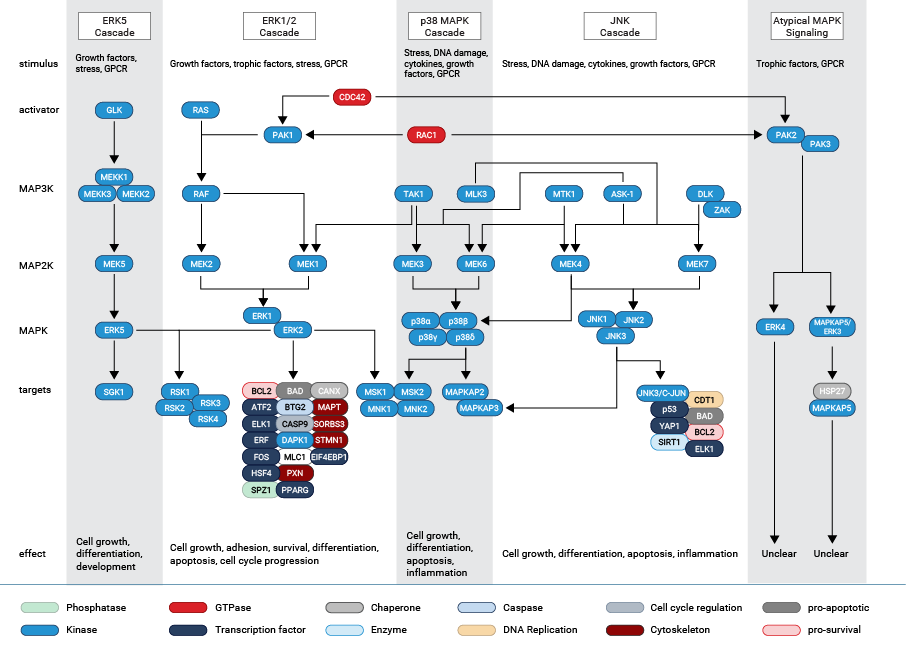The mitogen-activated protein kinase (MAPK) pathways are highly conserved intracellular signal transduction mechanisms that facilitate the transfer of extracellular signals from the membrane to intracellular targets. These pathways are integral to a multitude of biological functions, including cellular growth, proliferation, differentiation, motility, stress response, survival, and apoptosis.
MAPKs are activated in response to a wide spectrum of input signals. These include physiological signals such as hormones, cytokines, and growth factors, as well as endogenous stress and environmental stimuli. Traditionally, MAPKs are categorized into two main groups based on their activation triggers: mitogen-activated MAPKs, exemplified by extracellular signal-regulated kinase (ERK), and stress-activated MAPKs, represented by c-Jun N-terminal kinase (JNK) and p38.1
MAPK Pathway Antibodies:
The signaling cascades of MAPKs are initiated through the interaction of growth factors (GFs) with their specific growth factor receptors (GFRs). Typically, GFs bind to and activate transmembrane glycoproteins of the receptor tyrosine kinase (RTK) family, which in turn initiate the downstream signaling cascade. The MAPK pathways are organized in a three-tiered kinase cascade: a mitogen-activated protein kinase kinase kinase (MAPKKK or MAP3K) sits at the top of the pathway, responding to upstream signals and phosphorylating the intermediate kinase (MAPKK or MAP2K). The MAP2K then specifically phosphorylates and activates a MAPK. This linear kinase cascade ensures a highly regulated transmission of signals, culminating in the activation of MAPKs that interact with a variety of substrates to mediate specific cellular responses tailored to the nature of the input signal.2
 Figure. Schematic representation of the MAPK pathways. In mammals, four primary MAPKs—ERK1/2, JNK1/2/3, p38 α/β/γ/δ, and ERK5—have been identified, alongside several atypical MAPKs (ERK3/4 and ERK7/8) with unique activation mechanisms.
Figure. Schematic representation of the MAPK pathways. In mammals, four primary MAPKs—ERK1/2, JNK1/2/3, p38 α/β/γ/δ, and ERK5—have been identified, alongside several atypical MAPKs (ERK3/4 and ERK7/8) with unique activation mechanisms.
As the first MAPK pathway described, Ras-Raf-MEK-ERK signaling serves as a prototype of these kinase cascades. This pathway integrates signals from various extracellular agents via diverse receptors. Typically, receptor activation triggers the small GTPase Ras, primarily at the plasma membrane. Activated Ras recruits MAP3Ks, such as Raf-1 and B-Raf, to the plasma membrane, enabling their activation through dimerization and phosphorylation. Once activated, Raf transmits the signal to MAP2Ks, specifically MEK1 and MEK2, which are phosphorylated at two Ser residues within their activation loop. MEK1/2 then activate ERK1 and ERK2 by phosphorylating regulatory Thr and Tyr residues within the activation loop's Thr-Glu-Tyr domain. Activated ERK1/2 transmit signals to MAPK-activated protein kinases (MAPKAPKs) such as RSKs, MNKs, and MSKs, and other substrates localized in the cytoplasm, nucleus, or cellular organelles.3
Overall, the MAPK pathways are crucial for integrating diverse external signals and orchestrating precise intracellular responses. Rockland supports the various fields of MAPK research with the following list of antibodies.
MAPK Antibodies
| Product | Clonality | Reactivity | Applications |
| p38 Antibody | Polyclonal | Human, Mouse | WB, ELISA, IHC |
| p38 Antibody | Polyclonal | Broad | WB, IHC, IF, IP |
| p38 MAPK phospho T180/phospho Y182 Antibody | Polyclonal | Human | WB, IHC |
| p38 alpha MAPKinase Antibody | Monoclonal | Human | WB, IHC, IP |
| p44 Map Kinase Antibody | Polyclonal | Mouse | WB, ELISA, IP |
| ERK-MAPK Antibody | Polyclonal | Human, Mouse, Rat | WB |
| ERK-MAPK phospho T202/phospho Y204 Antibody | Polyclonal | Human, Mouse, Rat | WB, IHC |
| ERK1 N-Term Antibody | Polyclonal | Human, Mouse, Rat | WB, ELISA |
| ERK2 Antibody | Polyclonal | Human, Mouse | WB |
| ERK2 Internal Antibody | Monoclonal | Human, Mouse, Rat | WB, ELISA |
| ERK2 Internal Antibody | Polyclonal | Human, Mouse, Rat | WB, ELISA |
| ERK2 C-Term Antibody | Polyclonal | Human, Mouse, Rat | WB, ELISA |
| MAPK3 Antibody | Polyclonal | Human, Mouse, Rat | WB, IHC |
| MAPK 8/9 Antibody | Polyclonal | Human, Mouse, Rat | WB, IHC |
MAP2K Antibodies
| Product | Clonality | Reactivity | Applications |
| MEK1 N-Term Antibody | Polyclonal | Human, Mouse, Rat | WB, ELISA |
| MEK1 C-Term Antibody | Polyclonal | Human, Mouse, Rat | WB, ELISA, IHC |
| MEK1 C-Term Antibody | Monoclonal | Human, Mouse, Rat | WB, ELISA, IP |
| MEK1 phospho T292 Antibody | Polyclonal | Human | WB |
| MEK1 phospho T386 Antibody | Polyclonal | Human, Rat | WB |
| MEK1/2 phosphoS218/pS222 Antibody | Polyclonal | Human, Mouse | WB |
| MEK1 phosphoS222/MEK2 phosphoS226 Antibody | Monoclonal | Human, Mouse, Rat | WB, ELISA |
| MEK1/2 phosphoS218/pS222 Antibody | Polyclonal | Human, Mouse | WB |
| MEK2 N-Term Antibody | Polyclonal | Human, Mouse | WB, ELISA, IHC |
| MEK2 N-Term Antibody | Monoclonal | Human, Mouse, Rat | WB, ELISA, IP |
| MEK2 C-Term Antibody | Polyclonal | Human | WB, ELISA, IHC, IP |
| MEK2 C-Term Antibody | Monoclonal | Human, Mouse, Rat | WB, ELISA |
MAP3K Antibodies
| Product | Clonality | Reactivity | Applications |
| ASK1 Antibody | Polyclonal | Human | WB, ELISA, IHC, IF |
| ASK1 Antibody | Polyclonal | Human, Mouse | WB, ELISA, IHC, IF |
| ASK1 phospho S83 Antibody | Polyclonal | Human | WB, ELISA, IHC, IP |
| B-raf Antibody | Polyclonal | Human, Mouse, Rat | WB, ELISA |
| B-raf Antibody | Polyclonal | Human, Mouse | WB, ELISA, IHC, IF |
| C-raf Antibody | Polyclonal | Human, Mouse, Rat | WB, ELISA |
| MAPKAP1 Antibody | Polyclonal | Human, Mouse, Rat | WB, ELISA, IHC, IF |
| TAK1 Antibody Polyclonal |
Polyclonal | Human, Mouse, Rat | WB, ELISA, IF |
| TAO2 phospho S181 Antibody | Polyclonal | Human, Mouse, Rat | WB |
References